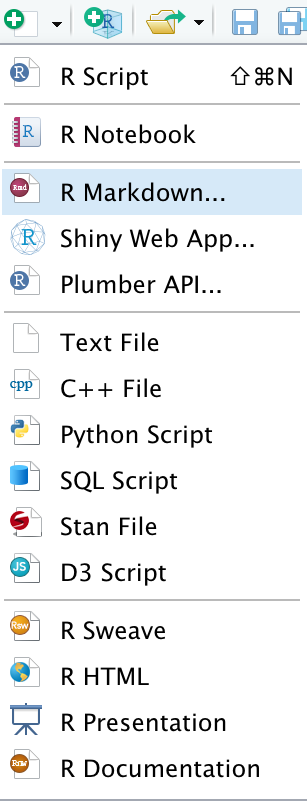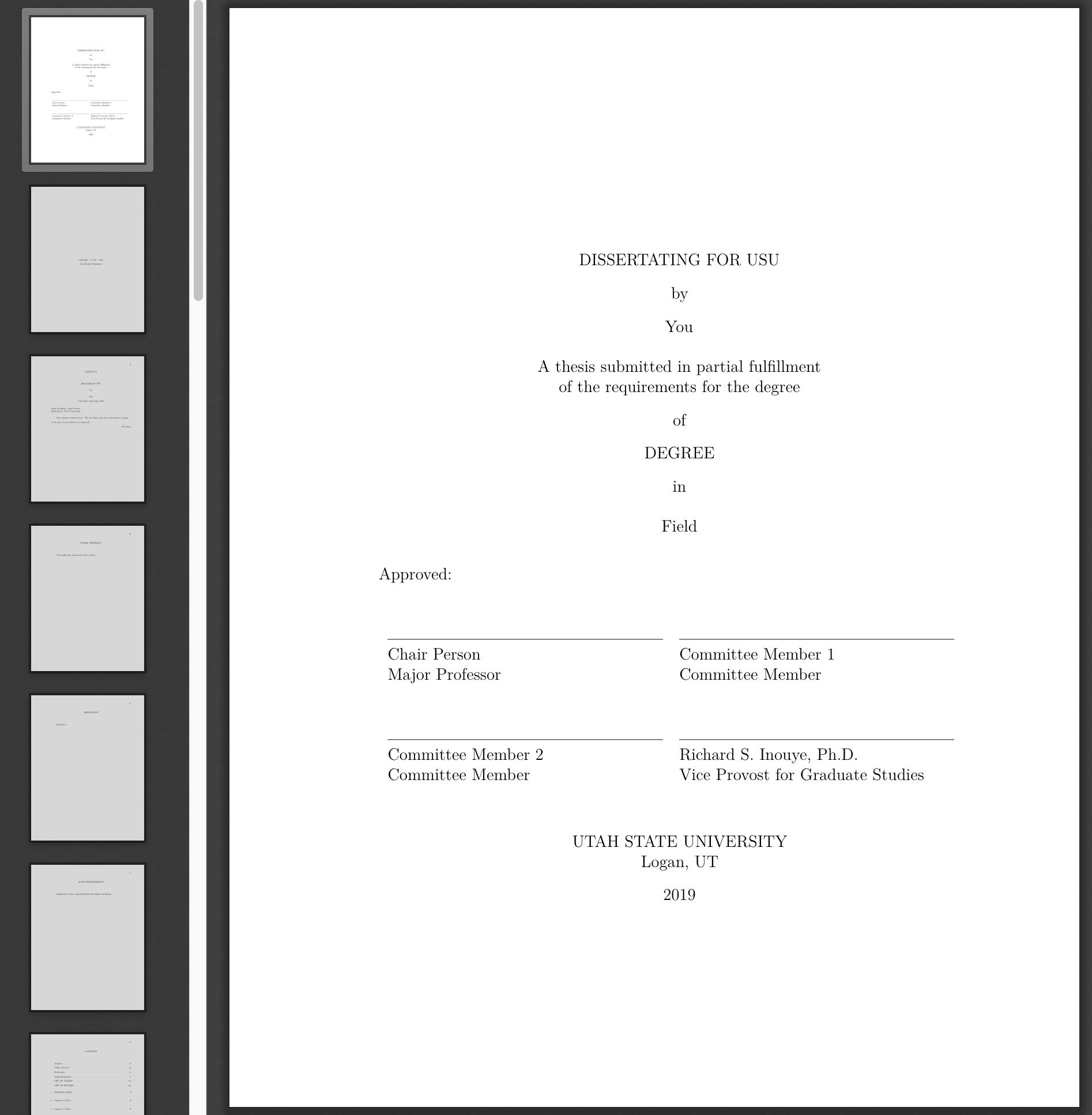The goal of dissertateUSU is to make two aspects of writing a
dissertation at Utah State University better:
- Formatting of the dissertation is automatically done for you
- All analyses are intimately tied to the document, making the work more reproducible
Ultimately, this allows the student to focus on the writing and the results without having to worry excessively about updating tables and figures, adjusting formatting of things like the title page and table of contents, and other minor (but important) aspects of getting the document correct.
It is up-to-date as of the 2020-21 graduate school formatting guidelines.
You can install dissertateUSU with:
remotes::install_github("tysonstanley/dissertateUSU")Importantly, this package requires the new release of LaTeX from your preferred distribution. Older versions will often encounter an error regarding “\counterwithin”. If this error comes up for you, then you need to update your LaTeX.
To use the package, after installing it–and restarting Rstudio–open up a new RMarkdown file:
and select the “Dissertate USU” template:
This will open up a new folder with a skeleton RMarkdown file:
This produces a document that matches the USU dissertation guidelines:
If you’d rather have the Master’s Thesis cover page, just remove the
committee5 and committee4 lines in the main .Rmd file.
- To put the title on two lines (see the thesis cover page above), use
\newline(or if that doesn’t work, use\\newline) at the point where you want the title to split to the second line. In general, USU wants the first of the two title lines to be longer than the second part. - If you don’t need a section (e.g., “Public Abstract”, “Chapter 5”,
etc.), remove it from the main
.Rmdfile. For example, if you want to remove the “Public Abstract”, remove all the lines starting from the\newpagein that section down to the actual wordsPublically abstracted words go here.. It will then not be included in the knitted document. - Currently, the package uses APA 7 formatting for citations (by
default) but this can be altered by downloading a new
.cslfile and specifying it in the yaml, by replacing theapa7.cslin thepandoc_args: [ "--csl", "apa7.csl" ]argument with your file name. The package also comes withapa6.cslto use. - Although the School of Graduate Studies at Utah State University has
approved the use of
dissertateUSU, before using it, talk to your committee chair and your graduate program coordinator to make sure it is approved by your department.
In the folder, there are other RMarkdown files called Chapter1.Rmd,
Chapter2.Rmd, etc. These are the files where you will do the writing
and analyzing. The main RMarkdown file will bring all these files
together into one document. The only things you need to update in the
main RMarkdown file is the yaml information, the abstracts,
acknowledgments, and dedication.
To add appendices, you can use the following at the very end of the
skeleton .Rmd file:
<div id="refs"></div>
<!-- Appendix -->
\clearpage
\addcontentsline{toc}{chapter}{APPENDICES}
\fancyhead[L]{Appendices}
\fancyhead[R]{Page\newline\thepage}
\fancyfoot[C]{}
\vspace*{\fill}
\begin{center}
APPENDICES
\end{center}
\vspace*{\fill}
\addcontentsline{toc}{section}{Appendix A}
\section*{Appendix A}
...appendix stuff...
A now common approach for dissertations at Utah State University are
multi-paper dissertations. To make this work in dissertateUSU, you
will need to use four steps. First, note each of the chapters that are
the individual papers (e.g., chapters 2, 3, and 4).
First, add the bibliography line to the yaml for each chapter that will
be its own paper. To do that, add the following lines to the top of the
.Rmd file, where yourbibfile.bib is the name of the bib file you are
using. At the same time, remove the \newpage to \chapter{} from the
core .Rmd file for that specific chapter. Do this for each chapter.
---
bibliography: yourbibfile.bib
---
\newpage
\fancyhead[R]{\thepage}
\fancyfoot[C]{}
\chapter{Chapter name}
Second, add the following at the end of the chapter.
\section*{References}
\setlength{\parindent}{-0.6in}
\setlength{\leftskip}{0.6in}
\setlength{\parskip}{6pt}
\noindent
Third, to reset the paragraph formatting for the following chapter, at the beginning of the next chapter add:
\setlength{\parindent}{0.4in}
\setlength{\leftskip}{0.0in}
\setlength{\parskip}{6pt}
\noindent
Finally, change the core .Rmd code chunks from:
```{r, child="Chapter2.Rmd"}
```to:
```{r, results='asis'}
chapter_knit("Chapter2")
```This will do an alternative form of knitting (and will create a .md
and .tex file for the chapter).
The package is still undergoing some development and we would love feedback on any aspect that doesn’t work as expected.
We also want to thank the
rticles package for the
functionality for dissertateUSU. The idea to make this package, as
well as its design, was derived from the rticles package.
And thanks to David Jenks for his help finding LaTeX bugs from older LaTeX releases.






